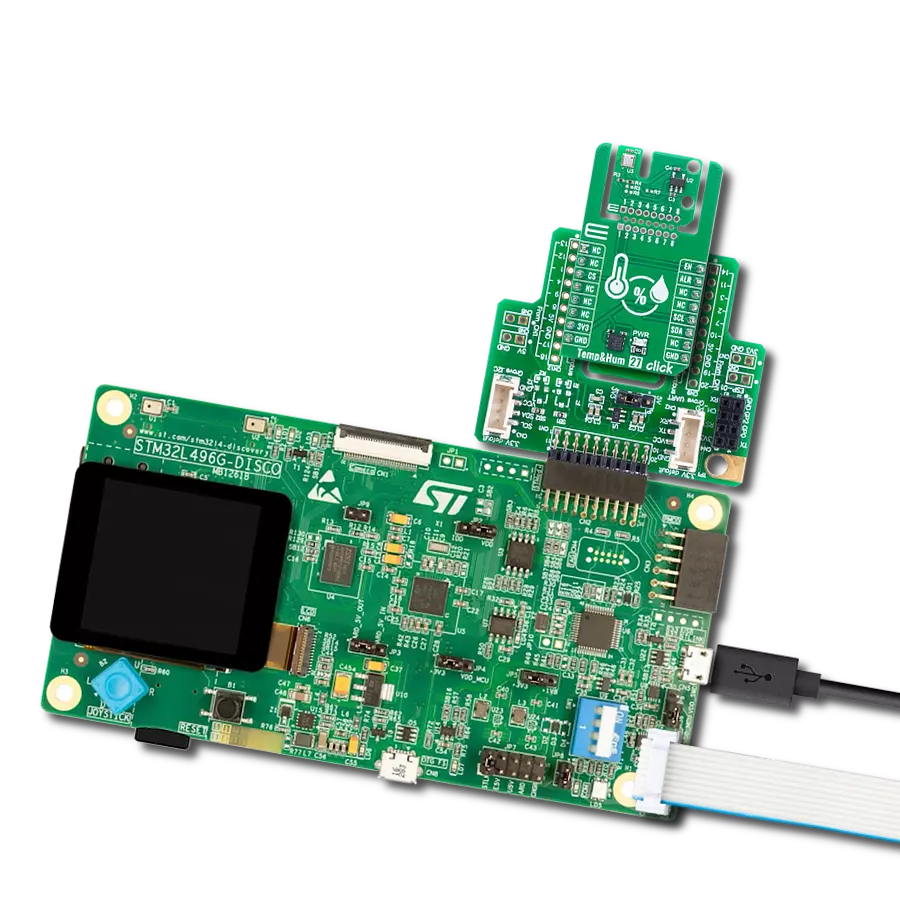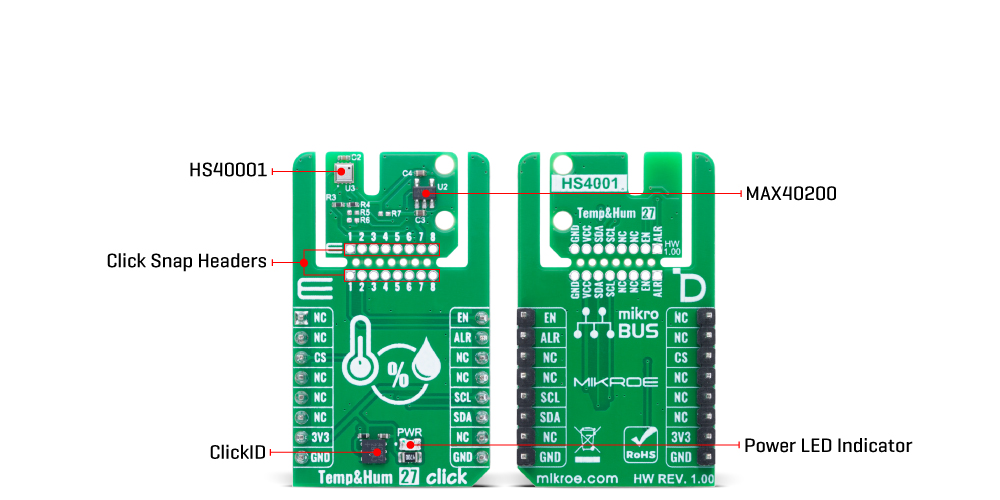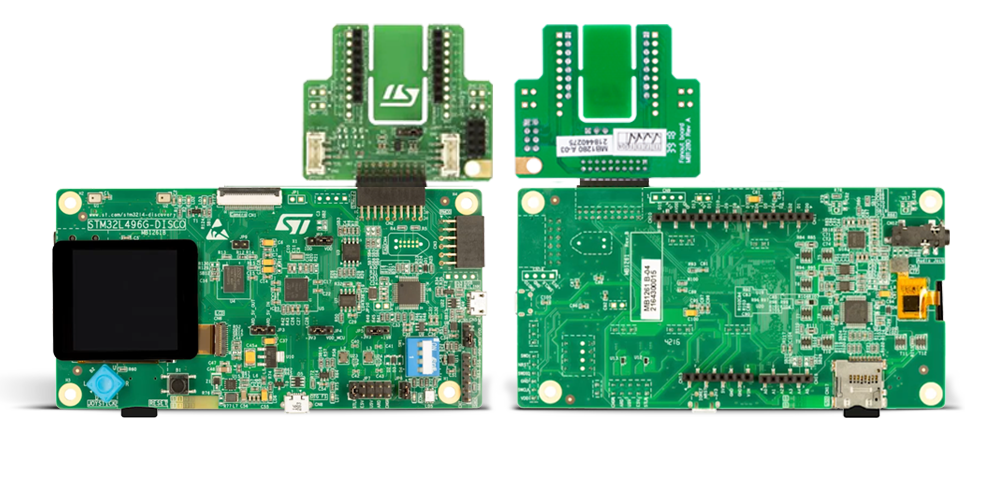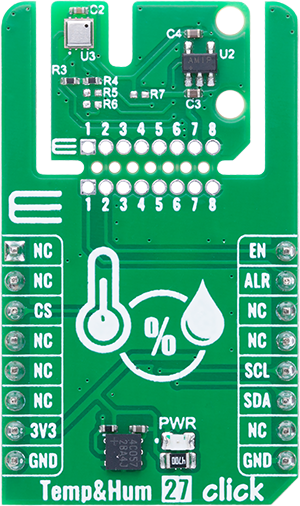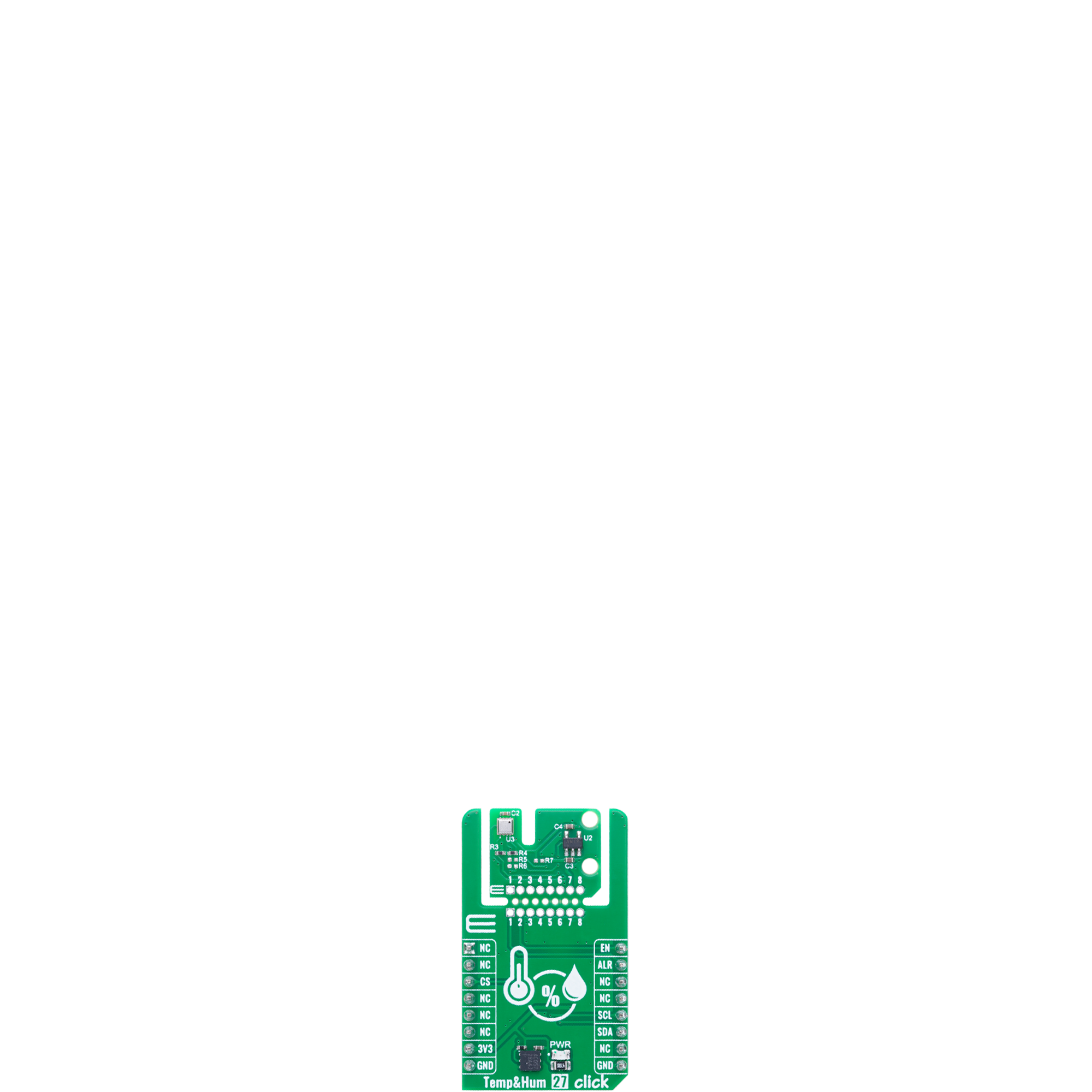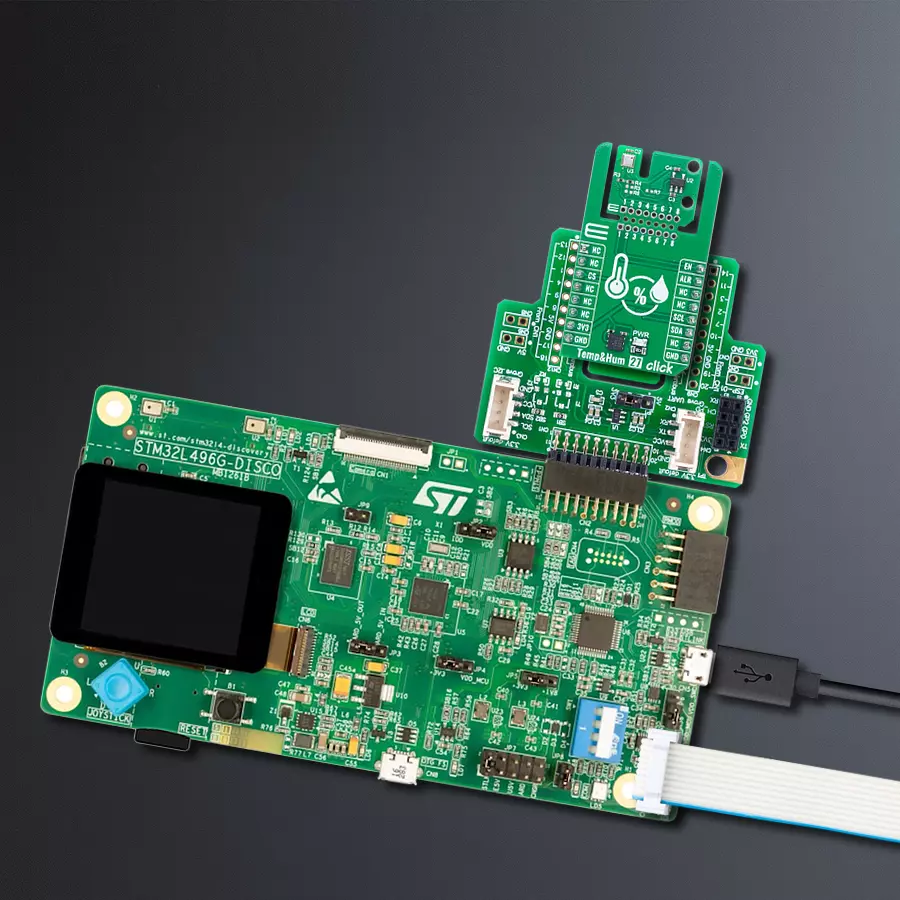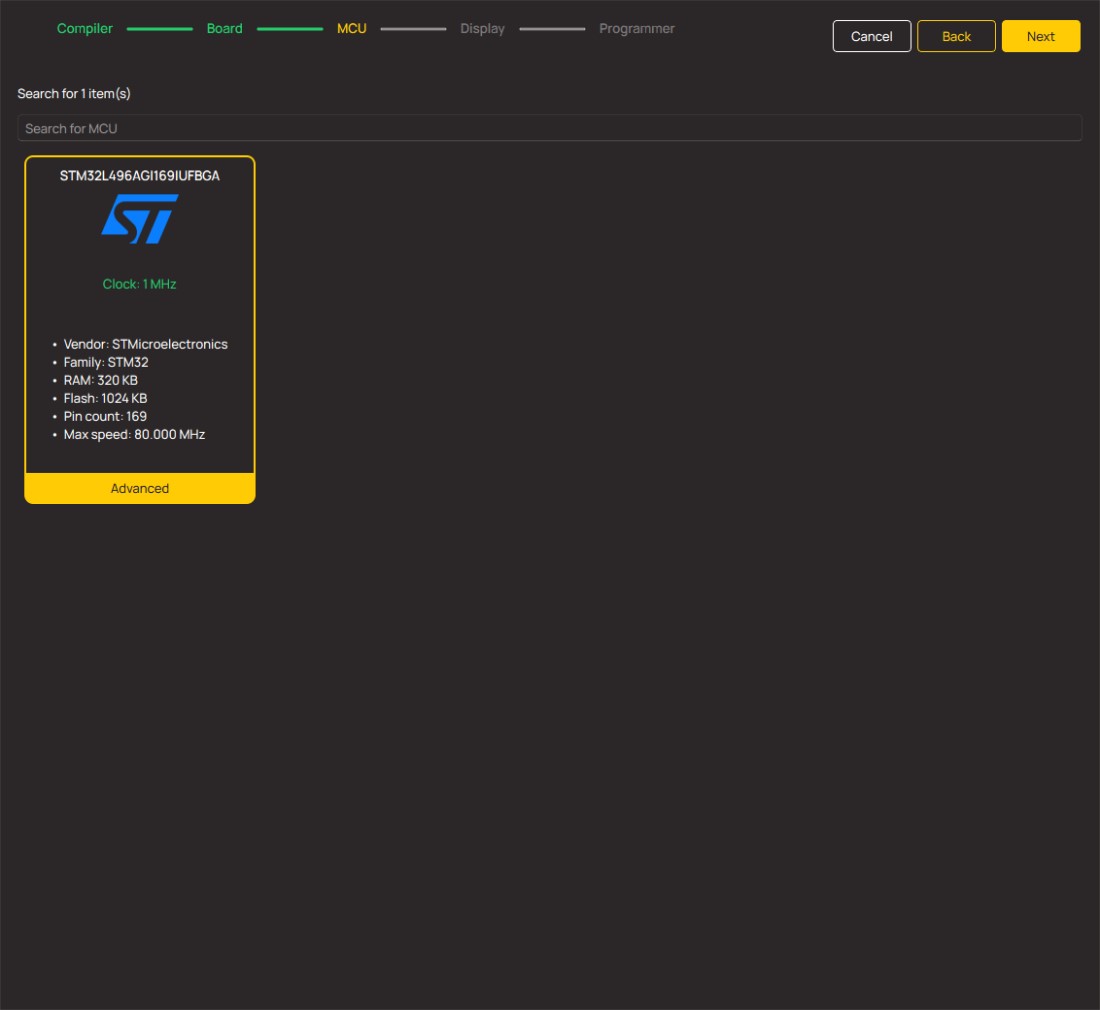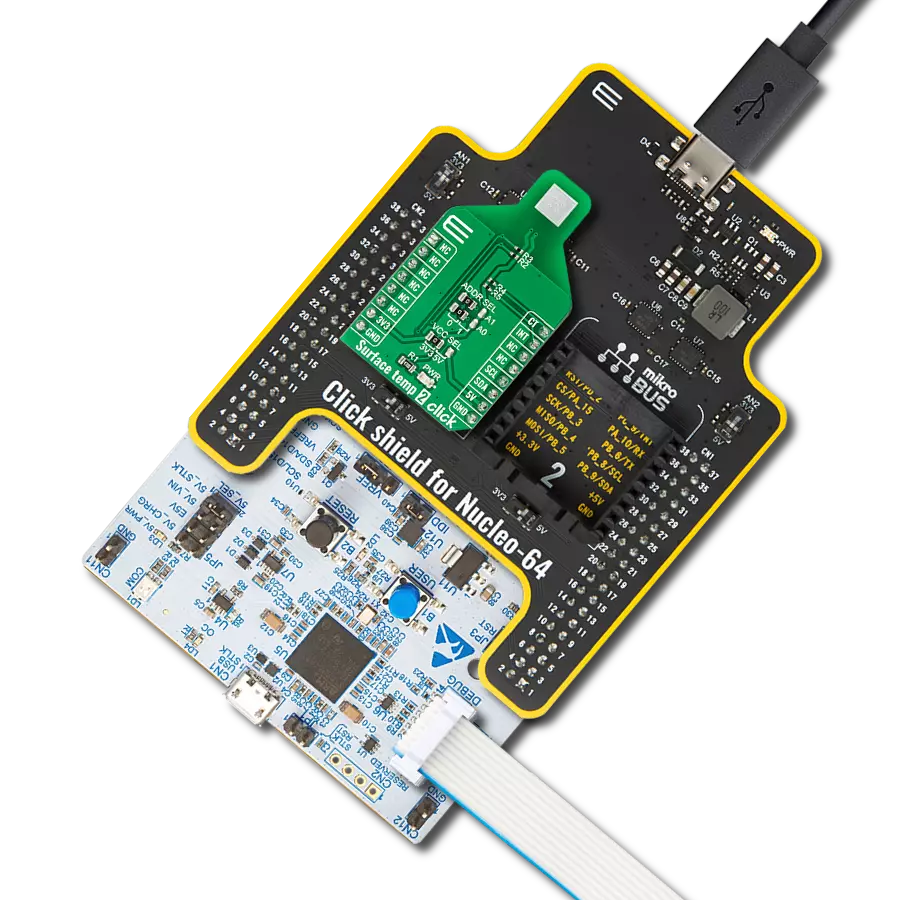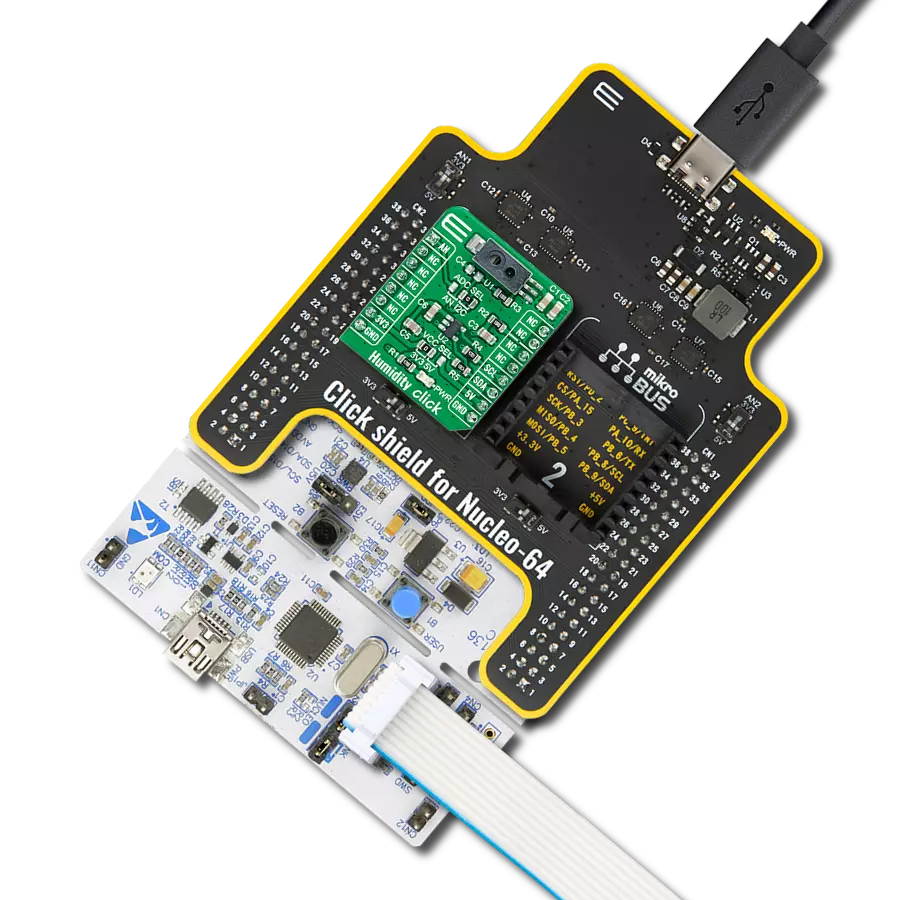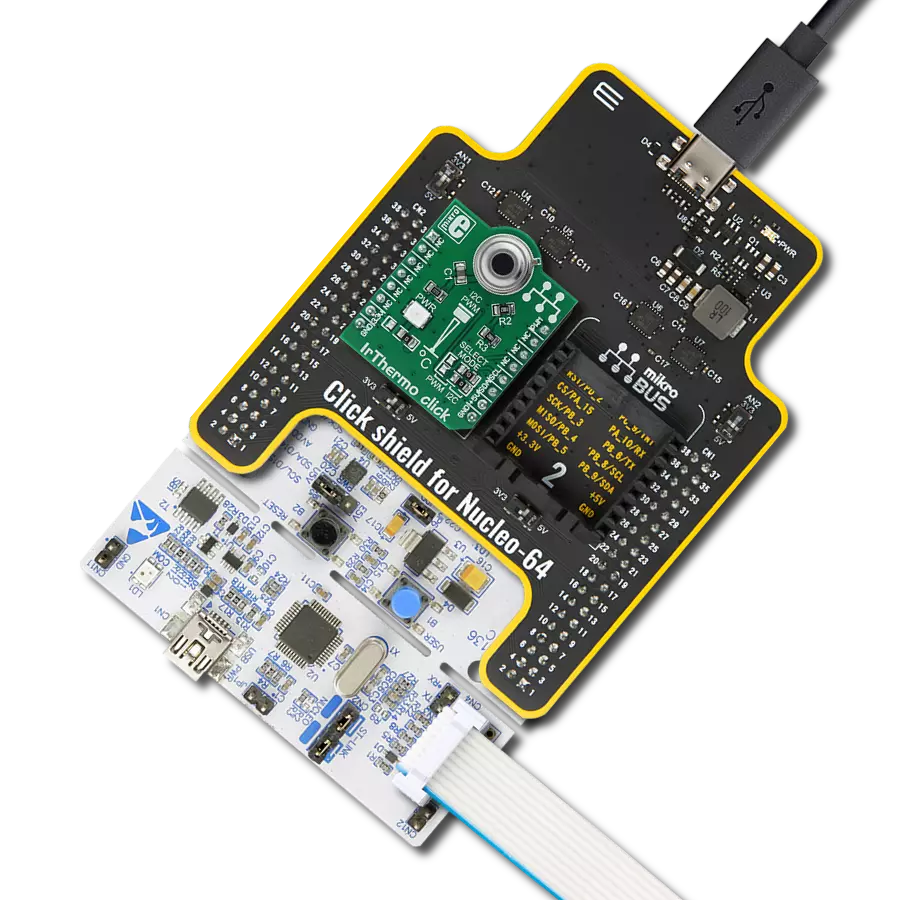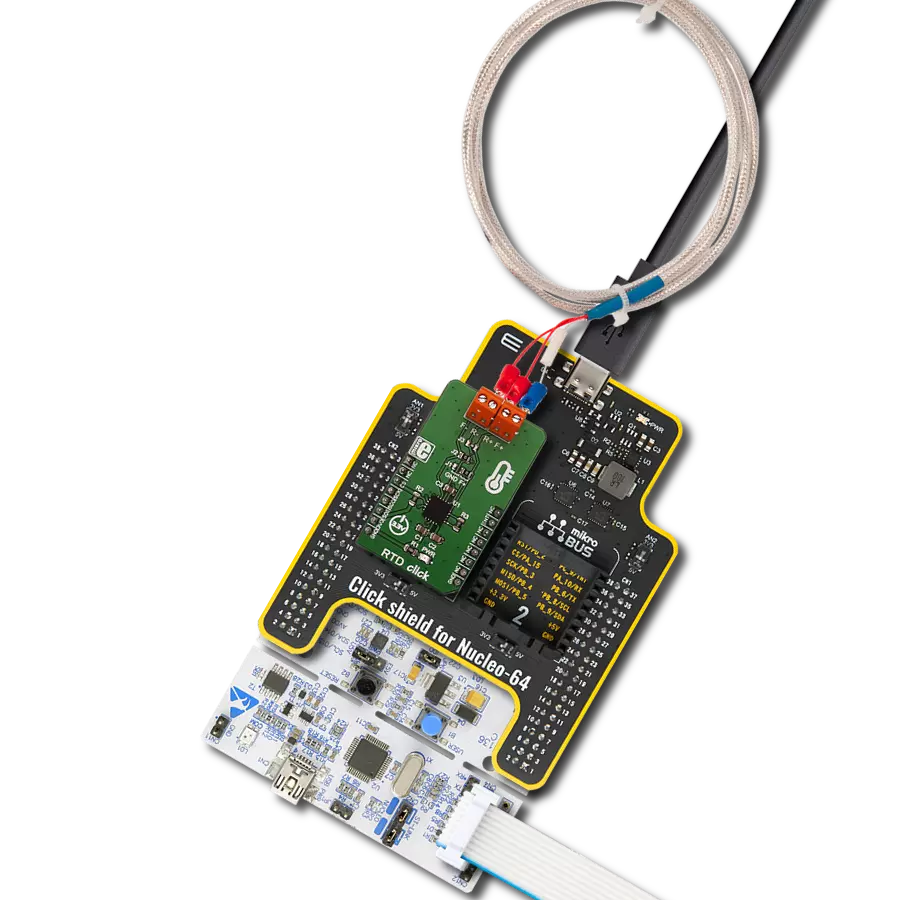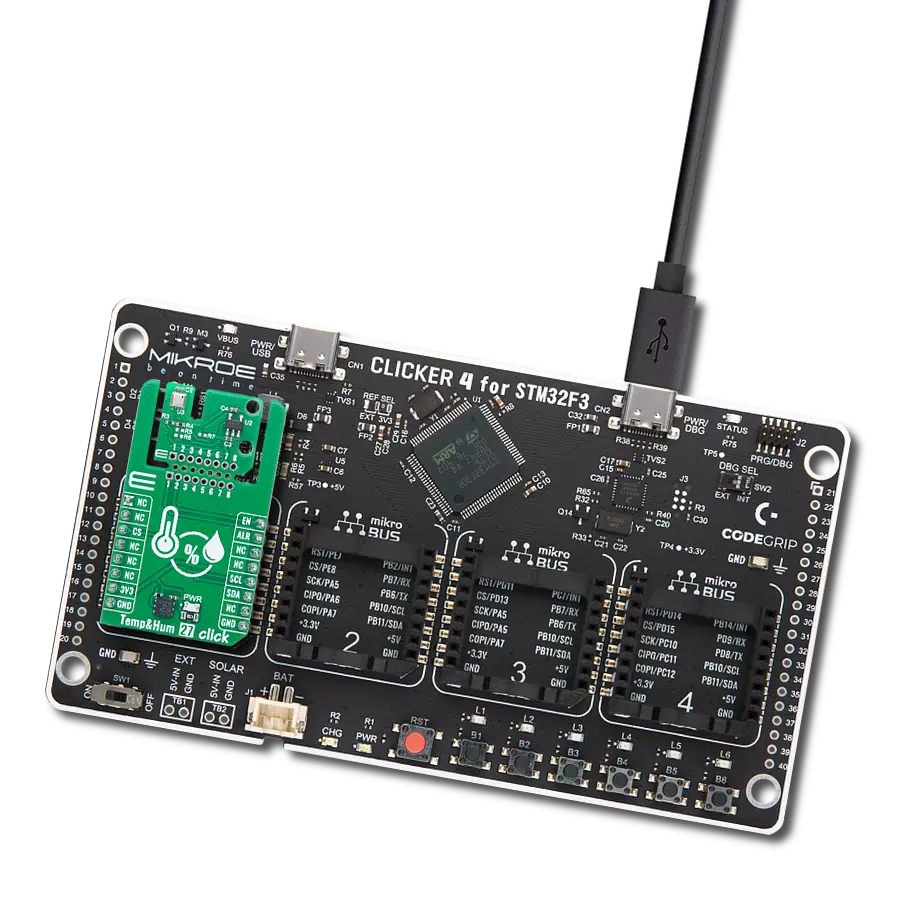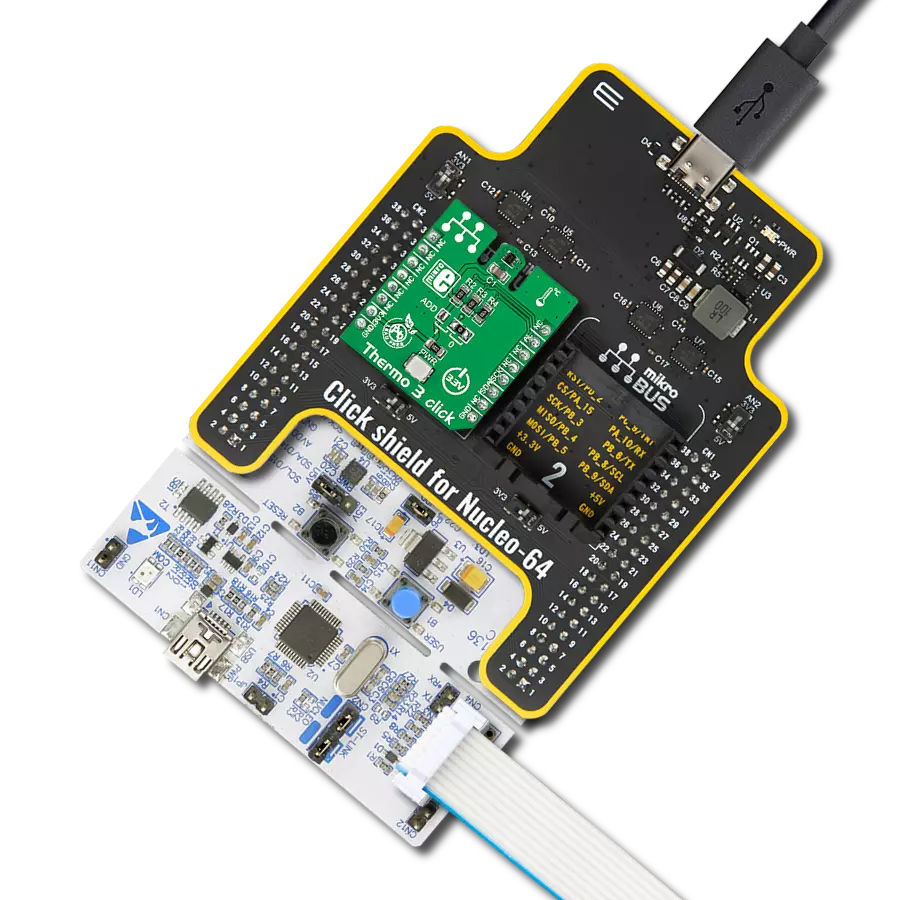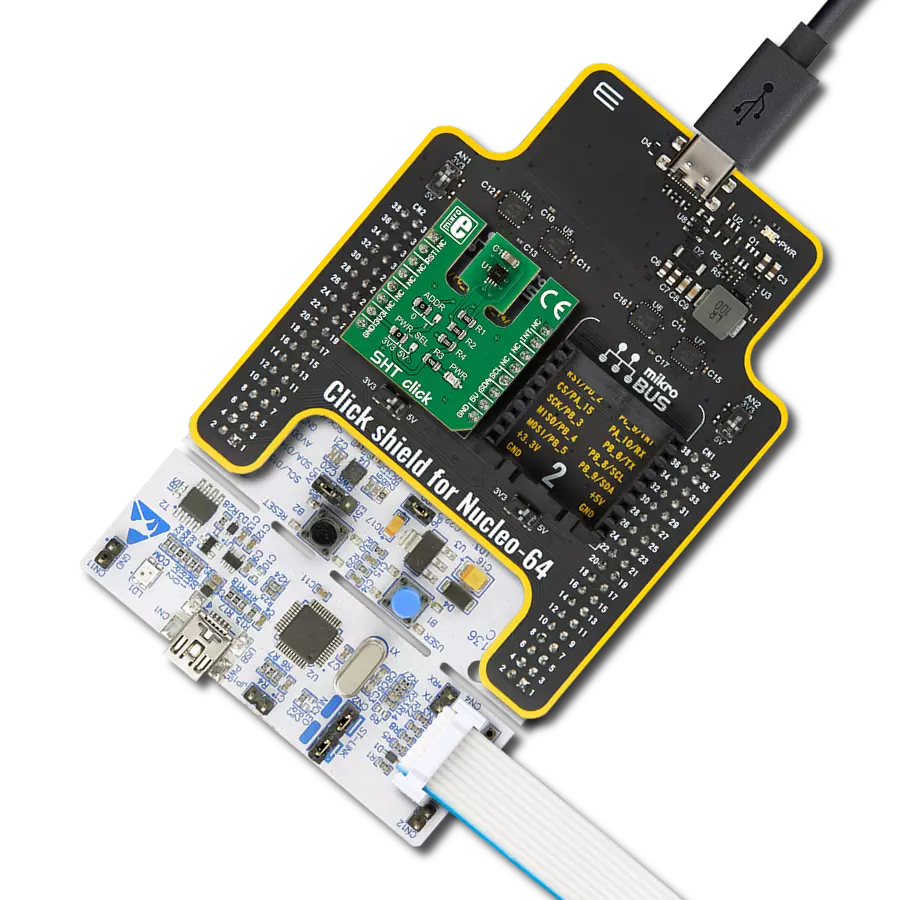在严苛环境中实现可靠的温湿度测量,具备快速响应与长期稳定性
A
A
硬件概览
它是如何工作的?
Temp&Hum 27 Click 基于 Renesas 的 HS4001,这是一款高性能的 MEMS 温湿度传感器,具有完全校准和温度补偿的数字输出,通过标准 I²C 接口实现通信。该板适用于各种工业与汽车应用场景,提供高精度、稳定可靠的温湿度测量。HS4001 具备 NIST 可溯源的出厂校准、符合 ISO/IEC 17025 的生产测试标准,并集成先进的传感器级保护,确保在长期使用中对环境应力、老化和挥发性化学物质具有良好的抵抗能力。其工作温度范围宽广,工业级支持 -40°C 至 +125°C,车规级支持 -40°C 至 +105°C;在 -10°C 至 +80°C 的关键区间内,典型精度为 ±1.5%RH(湿
度)和 ±0.2°C(温度)。支持多档可编程分辨率,最高达 14 位,典型湿度分辨率为 0.04%,典型湿度响应时间仅为 4 秒。这些特性使 Temp&Hum 27 Click 成为气候控制系统、HVAC、楼宇自动化、医疗仪器、气象监测、家电及便携式或数据记录设备的理想选择,尤其适用于受控与严苛环境下的应用。该板支持 MIKROE 最新推出的 Click Snap 结构设计,允许通过 PCB 预留断点将传感器区域独立分离,实现灵活部署。Snap 区域包含 1–8 引脚,可独立访问传感器信号,另设有固定螺丝孔,便于将传感器牢固安装在目标位置。Temp&Hum 27 Click 通过 I²C 接口与主控
MCU 通信,支持最高 400kHz 的通信速率,确保数据传输高效稳定。除通信引脚外,板载还设有一个 ALERT(ALR)引脚,用于在周期测量模式下指示测量数据就绪,或触发主控 MCU 的中断,以便在温度或湿度超出设定范围时执行相应动作。为实现对 HS4001 的启用与禁用,该板集成了 Analog Devices 的 MAX40200 电源开关芯片,通过 EN 引脚控制传感器供电。该 Click 板仅支持 3.3V 逻辑电平,如需与其他逻辑电平的 MCU 搭配使用,须进行电平转换。此外,该板配套提供易于使用的软件库和示例代码,便于用户快速开发与集成。
功能概述
开发板
32L496GDISCOVERY Discovery 套件是一款功能全面的演示和开发平台,专为搭载 Arm® Cortex®-M4 内核的 STM32L496AG 微控制器设计。该套件适用于需要在高性能、先进图形处理和超低功耗之间取得平衡的应用,支持无缝原型开发,适用于各种嵌入式解决方案。STM32L496AG 采用创新的节能架构,集成
了扩展 RAM 和 Chrom-ART 图形加速器,在提升图形性能的同时保持低功耗,使其特别适用于音频处理、图形用户界面和实时数据采集等对能效要求较高的应用。为了简化开发流程,该开发板配备了板载 ST-LINK/V2-1 调试器/编程器,提供即插即用的调试和编程体验,使用户无需额外硬件即可轻松加载、调
试和测试应用程序。凭借低功耗特性、增强的内存能力以及内置调试工具,32L496GDISCOVERY 套件是开发先进嵌入式系统、实现高效能解决方案的理想选择。
微控制器概述
MCU卡片 / MCU
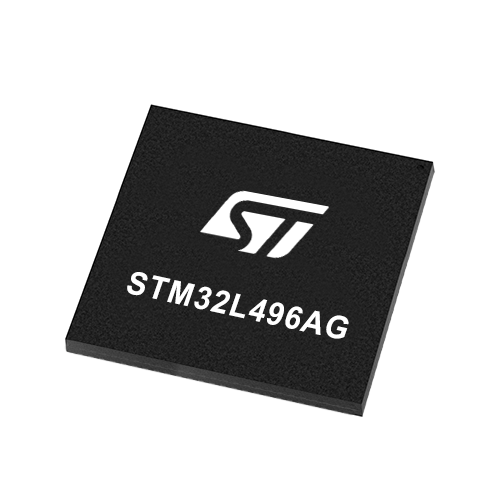
建筑
ARM Cortex-M4
MCU 内存 (KB)
1024
硅供应商
STMicroelectronics
引脚数
169
RAM (字节)
327680
使用的MCU引脚
mikroBUS™映射器
“仔细看看!”
Click board™ 原理图
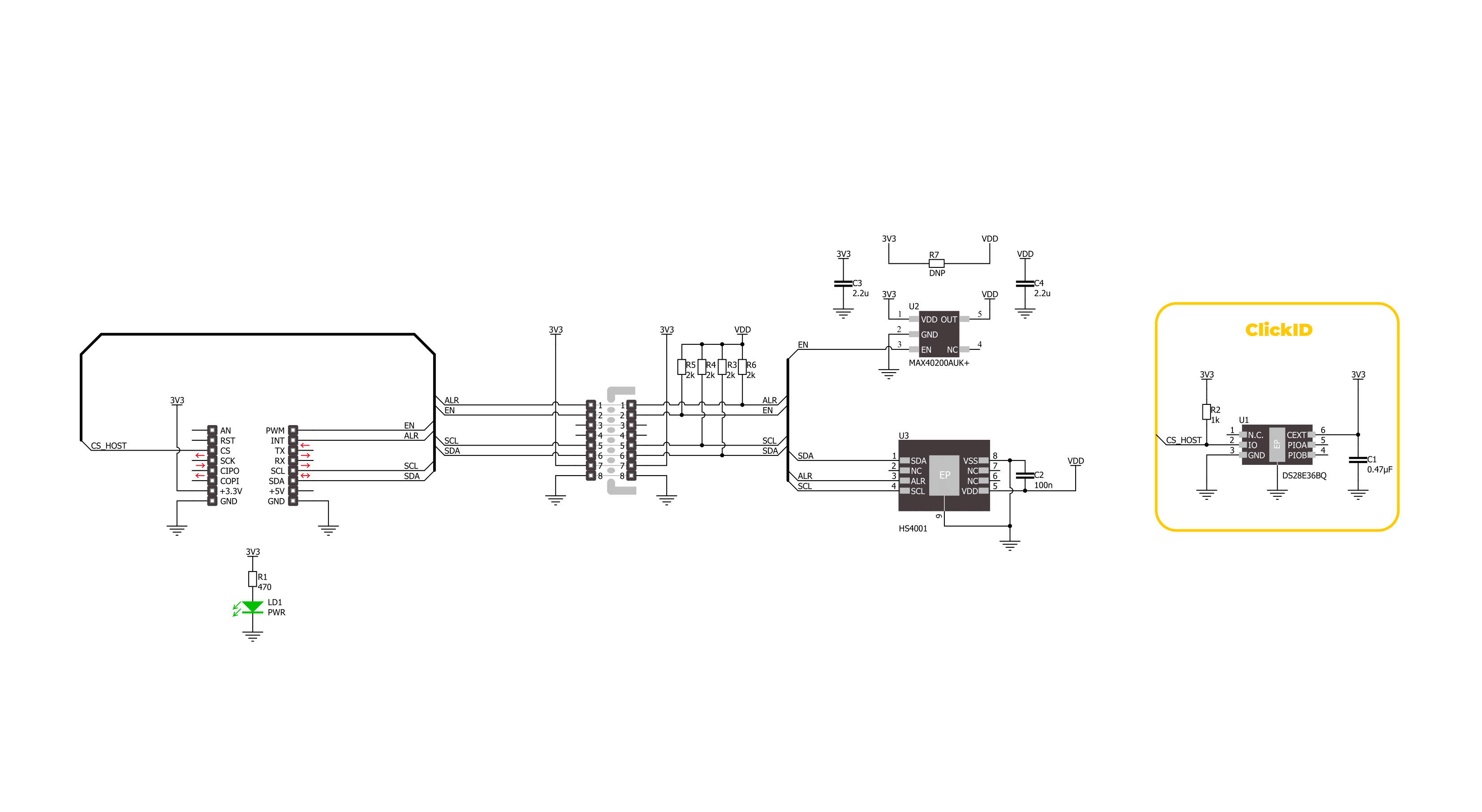
一步一步来
项目组装
实时跟踪您的结果
应用程序输出
1. 应用程序输出 - 在调试模式下,“应用程序输出”窗口支持实时数据监控,直接提供执行结果的可视化。请按照提供的教程正确配置环境,以确保数据正确显示。

2. UART 终端 - 使用UART Terminal通过USB to UART converter监视数据传输,实现Click board™与开发系统之间的直接通信。请根据项目需求配置波特率和其他串行设置,以确保正常运行。有关分步设置说明,请参考提供的教程。

3. Plot 输出 - Plot功能提供了一种强大的方式来可视化实时传感器数据,使趋势分析、调试和多个数据点的对比变得更加直观。要正确设置,请按照提供的教程,其中包含使用Plot功能显示Click board™读数的分步示例。在代码中使用Plot功能时,请使用以下函数:plot(insert_graph_name, variable_name);。这是一个通用格式,用户需要将“insert_graph_name”替换为实际图表名称,并将“variable_name”替换为要显示的参数。

软件支持
库描述
Temp&Hum 27 Click 演示应用程序使用 NECTO Studio开发,确保与 mikroSDK 的开源库和工具兼容。该演示设计为即插即用,可与所有具有 mikroBUS™ 插座的 开发板、入门板和 mikromedia 板完全兼容,用于快速实现和测试。
示例描述
本示例演示了如何使用 Temp&Hum 27 Click 板,通过周期性测量读取环境温度和相对湿度数值。设备初始化并以 1Hz 频率启动周期测量模式后,应用程序会等待 ALERT 引脚拉低以指示数据就绪,然后将测量结果记录并通过 USB UART 输出。
关键功能:
temphum27_cfg_setup- 初始化 Click 配置结构体为默认值。temphum27_init- 初始化使用该 Click 板所需的所有引脚与外设。temphum27_get_alert_pin- 读取 ALR(ALERT)引脚的逻辑电平状态temphum27_start_periodic_meas- 配置并启动指定频率下的周期性测量模式。temphum27_read_data_periodic- 在周期性测量模式下读取温度和/或湿度数据。temphum27_read_sensor_id- 读取唯一的 32 位传感器 ID。
应用初始化
初始化日志系统和 Click 板驱动,重置设备,读取并记录传感器 ID,然后以每秒一次的速率启动周期性测量。
应用任务
等待 ALERT 引脚拉低,表示新测量数据已就绪,然后读取温度与湿度值并通过 USB UART 进行日志输出。
开源
代码示例
完整的应用程序代码和一个现成的项目可以通过NECTO Studio包管理器直接安装到NECTO Studio。 应用程序代码也可以在MIKROE的GitHub账户中找到。
/*!
* @file main.c
* @brief TempHum 27 Click example
*
* # Description
* This example demonstrates the use of the TempHum 27 Click board by reading ambient temperature
* and relative humidity values using periodic measurements. After initializing the device and
* starting the periodic mode at 1 Hz, the application waits for the ALERT pin to indicate data
* readiness and then logs the measurements to the USB UART terminal.
*
* The demo application is composed of two sections :
*
* ## Application Init
* Initializes the logger and the Click driver, resets the device, reads and logs the sensor ID,
* and starts periodic measurements with a 1-second output rate.
*
* ## Application Task
* Waits for the ALERT pin to go low indicating new measurement data is available, then reads
* and logs the temperature and humidity values.
*
* @author Stefan Filipovic
*
*/
#include "board.h"
#include "log.h"
#include "temphum27.h"
static temphum27_t temphum27;
static log_t logger;
void application_init ( void )
{
log_cfg_t log_cfg; /**< Logger config object. */
temphum27_cfg_t temphum27_cfg; /**< Click config object. */
/**
* Logger initialization.
* Default baud rate: 115200
* Default log level: LOG_LEVEL_DEBUG
* @note If USB_UART_RX and USB_UART_TX
* are defined as HAL_PIN_NC, you will
* need to define them manually for log to work.
* See @b LOG_MAP_USB_UART macro definition for detailed explanation.
*/
LOG_MAP_USB_UART( log_cfg );
log_cfg.is_interrupt = false;
log_init( &logger, &log_cfg );
log_info( &logger, " Application Init " );
// Click initialization.
temphum27_cfg_setup( &temphum27_cfg );
TEMPHUM27_MAP_MIKROBUS( temphum27_cfg, MIKROBUS_1 );
if ( I2C_MASTER_ERROR == temphum27_init( &temphum27, &temphum27_cfg ) )
{
log_error( &logger, " Communication init." );
for ( ; ; );
}
uint32_t sensor_id = 0;
if ( TEMPHUM27_ERROR == temphum27_read_sensor_id ( &temphum27, &sensor_id ) )
{
log_error( &logger, " Sensor ID read." );
for ( ; ; );
}
log_printf ( &logger, " Sensor ID: 0x%.8LX\r\n", sensor_id );
if ( TEMPHUM27_OK == temphum27_start_periodic_meas ( &temphum27, TEMPHUM27_PERIODIC_FREQ_1S ) )
{
log_printf ( &logger, " Periodic measurement started with 1Hz output\r\n" );
}
log_info( &logger, " Application Task " );
}
void application_task ( void )
{
float temperature = 0;
float humidity = 0;
// Wait for a periodic data ready (alert pin falling edge)
while ( !temphum27_get_alert_pin ( &temphum27 ) );
while ( temphum27_get_alert_pin ( &temphum27 ) );
if ( TEMPHUM27_OK == temphum27_read_data_periodic ( &temphum27, &temperature, &humidity ) )
{
log_printf ( &logger, " Temperature: %.2f degC\r\n", temperature );
log_printf ( &logger, " Humidity: %.2f %%RH\r\n\n", humidity );
}
}
int main ( void )
{
/* Do not remove this line or clock might not be set correctly. */
#ifdef PREINIT_SUPPORTED
preinit();
#endif
application_init( );
for ( ; ; )
{
application_task( );
}
return 0;
}
// ------------------------------------------------------------------------ END
额外支持
资源
类别:温度与湿度
